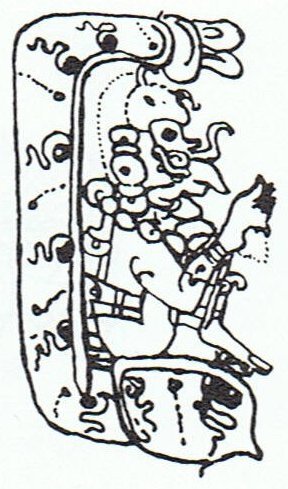 |
 |
 |
 |
 |
|
Ab6-76 |
Ab6-77 |
Ab6-78 |
Ab6-79 |
Ab6-80 |
 |
 |
 |
 |
 |
|
Ab6-81 |
Ab6-82 |
Ab6-83 |
Ab6-84 |
Ab6-85 |
If we look at
these 10 glyphs (once grouped thus by me from
the visual
cues only) as a list, then the kea glyph will be
number 9, and the following ihe tau appropriately marks number 10.
At 10 it is all over.
Tagata in
Ab6-76 is depicted in profile to enable us to see his
open mouth - he is 'eating' (i.e. growing). Then follows a
peculiar combination of Rogo - note the form of his
right arm - seen in profile and with his bottom obliquely cut off, together with
a puo sign.
A similar puo forms the central 'body' of kea in Ab6-84.
Another Rogo is
depicted en face immediately below Rogo
in Ab6-77, this one holding a double nuku (whích possibly
should be understood as autumn 'turning around', leaving). His right arm
looks like the crescent of Moon. We should remember what Ogotemmêli
said - viz. that in the beginning, before fire had been brought down to
earth, the arms and legs of man had no joints and were
flexible like serpents. In Ab6-77 the right arm of Rogo has joints,
in Ab6-82 it is his left (front) arm which has joints.
If the first 5
glyphs represent the 1st half of a cycle and the next
group the 2nd half, then we should compare parallel
signs, for instance the redmarked glyphs
below:
 |
 |
 |
 |
 |
|
Ab6-76 |
Ab6-77 |
Ab6-78 |
Ab6-79 |
Ab6-80 |
 |
 |
 |
 |
 |
|
Ab6-81 |
Ab6-82 |
Ab6-83 |
Ab6-84 |
Ab6-85 |
Corresponding to
the 2 henua glyphs in the first group we find a bent
henua respectively an ihe tau sign. I
interpret the bent henua as a Moon variant of the
otherwise straight Sun henua 'stick'. The first
group above could be referring to the light from Sun and the
second group to the light from Moon. Ihe tau
indicates how the season of Moon light has
ended.
To the right and
left of the puo body in Ab6-84 we can imagine the 2
'faces' of Moon - waxing and waning. The leg in front is
formed as a waning crescent and the head at the back has a
big open mouth. The central body is depicted as a different
entity, maybe the night when waxing moon has left - i.e.
the full moon night. Rogo in
Ab6-82 could correspond to the night when moon is
invisible, and the double nuku could refer to how the old
month is 'turning around'.
The double
nuku would then have a double function, not only to indicate
the dark night when Moon is regenerated (bathing in vai
ora), but also to indicate where in the year the counting by
Moon should restart. Rogo in Ab6-77
stands at midsummer, presumably, which explains why he is holding a puo sign (to indicate
Spring Sun has 'gone down into earth'):

Next we
will try a numerical approach.